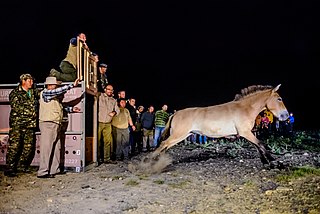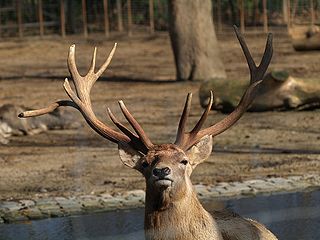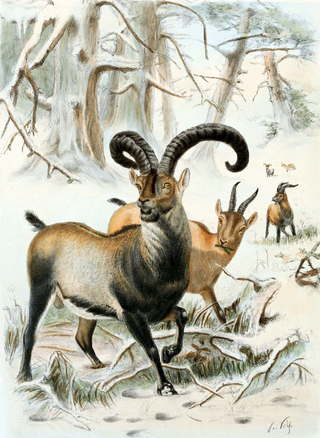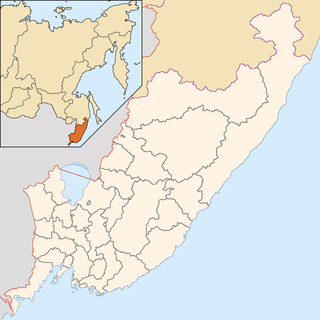
The tiger is the largest living cat species and a member of the genus Panthera native to Asia. It has a powerful, muscular body with a large head and paws, a long tail, and orange fur with black, mostly vertical stripes. It is traditionally classified into nine recent subspecies, though some recognise only two subspecies, namely mainland Asian tigers and island tigers of the Sunda Islands.

Species reintroduction is the deliberate release of a species into the wild, from captivity or other areas where the organism is capable of survival. The goal of species reintroduction is to establish a healthy, genetically diverse, self-sustaining population to an area where it has been extirpated, or to augment an existing population. Species that may be eligible for reintroduction are typically threatened or endangered in the wild. However, reintroduction of a species can also be for pest control; for example, wolves being reintroduced to a wild area to curb an overpopulation of deer. Because reintroduction may involve returning native species to localities where they had been extirpated, some prefer the term "reestablishment".

The Siberian tiger or Amur tiger is a population of the tiger subspecies Panthera tigris tigris native to the Russian Far East, Northeast China and possibly North Korea. It once ranged throughout the Korean Peninsula, but currently inhabits mainly the Sikhote-Alin mountain region in southwest Primorye Province in the Russian Far East. In 2005, there were 331–393 adult and subadult Siberian tigers in this region, with a breeding adult population of about 250 individuals. The population had been stable for more than a decade because of intensive conservation efforts, but partial surveys conducted after 2005 indicate that the Russian tiger population was declining. An initial census held in 2015 indicated that the Siberian tiger population had increased to 480–540 individuals in the Russian Far East, including 100 cubs. This was followed up by a more detailed census which revealed there was a total population of 562 wild Siberian tigers in Russia. As of 2014, about 35 individuals were estimated to range in the international border area between Russia and China.

The Ili is a river in Northwest China and Southeastern Kazakhstan. It flows from the Ili Kazakh Autonomous Prefecture of the Xinjiang Uighur Autonomous Region to the Almaty Region in Kazakhstan.

The Caspian tiger was a Panthera tigris tigris population native to eastern Turkey, northern Iran, Mesopotamia, the Caucasus around the Caspian Sea, Central Asia to northern Afghanistan and the Xinjiang region in western China. Until the Middle Ages, it was also present in southern Russia. It inhabited sparse forests and riverine corridors in this region until the 1970s. This population was regarded as a distinct subspecies and assessed as extinct in 2003.

The South China tiger is a population of the Panthera tigris tigris subspecies that is native to southern China. The population mainly inhabited the Fujian, Guangdong, Hunan and Jiangxi provinces. It has been listed as Critically Endangered on the China's Red List of Vertebrates and is possibly extinct in the wild since no wild individual has been recorded since the late 1980s. In the late 1990s, continued survival was considered unlikely because of low prey density, widespread habitat degradation and fragmentation, and other environmental issues in China. In the fur trade, it used to be called Amoy tiger.

The Siberian roe deer, eastern roe deer, or Asian roe deer, is a species of roe deer found in northeastern Asia. In addition to Siberia and Mongolia, it is found in Kazakhstan, the Tian Shan Mountains of Kyrgyzstan, eastern Tibet, the Korean Peninsula and forested regions of northern China.

The Bactrian deer, also called the Bukhara deer, Bokhara deer, or Bactrian wapiti, is a lowland subspecies of Central Asian red deer native to Central Asia. It is similar in ecology to the related Yarkand deer in that it occupies riparian corridors surrounded by deserts. The subspecies are separated from one another by the Tian Shan Mountains and probably form a primordial subgroup of the red deer.

The Saryesik Atyrau Desert is a desert in the Balkhash-Alakol Basin, eastern Kazakhstan. It stretches for about 400 km south of Lake Balkhash. It is a sand desert, relatively ecologically healthy with little erosion. There are a great number of small lakes and ponds in the desert, as well as occasional grasslands, that support a varied animal and bird population. In September 2017, English explorer Jamie Maddison completed a 70-mile, 30 hour ultra-marathon to make the first recorded on-foot crossing of the desert.

Pleistocene rewilding is the advocacy of the reintroduction of extant Pleistocene megafauna, or the close ecological equivalents of extinct megafauna. It is an extension of the conservation practice of rewilding, which aims to restore functioning, self-sustaining ecosystems through practices that may include species reintroductions.

A species that is extinct in the wild (EW) is one that has been categorized by the International Union for Conservation of Nature as only consisting of living members kept in captivity or as a naturalized population outside its historic range. Classification requires exhaustive surveys conducted within the species' known habitat with consideration given to seasonality, time of day, and life cycle. Once a species is classified as EW, the only way for it to be downgraded is through reintroduction.
The tiger is an iconic species. Tiger conservation attempts to prevent the animal from becoming extinct and preserving its natural habitat. This is one of the main objectives of the international animal conservation community. The Convention on International Trade in Endangered Species of Wild Fauna and Flora (CITES) has played a crucial role in improving international efforts for tiger conservation.

The Ussuri brown bear, also known as the Ezo brown bear, Russian grizzly bear, or the black grizzly bear, is a subspecies of the brown bear or a population of the Eurasian brown bear. One of the largest brown bears, a very large Ussuri brown bear may approach the Kodiak bear in size. It is not to be confused with the North American grizzly bear.

The wildlife of Russia inhabits terrain that extends across 12 time zones and from the tundra region in the far north to the Caucasus Mountains and prairies in the south, including temperate forests which cover 70% of the country. Russia's forests comprise 22% of the forest in the world as well as 33% of all temperate forest.

The Amur leopard is a leopard subspecies native to the Primorye region of southeastern Russia and northern China. It is listed as Critically Endangered on the IUCN Red List, as in 2007, only 19–26 wild leopards were estimated to survive in southeastern Russia and northeastern China.

The Turkmenian kulan, also called Transcaspian wild ass, Turkmenistani onager or simply the kulan, is a subspecies of onager native to Central Asia. It was declared Endangered in 2016.

De-extinction is the process of generating an organism that either resembles or is an extinct species. There are several ways to carry out the process of de-extinction. Cloning is the most widely proposed method, although genome editing and selective breeding have also been considered. Similar techniques have been applied to certain endangered species, in hopes to boost their genetic diversity. The only method of the three that would provide an animal with the same genetic identity is cloning. There are benefits and drawbacks to the process of de-extinction ranging from technological advancements to ethical issues.

The temperate rainforests of the Russian Far East are within the Russian federal subjects Primorsky Krai and Khabarovsk Krai and contains the Sikhote-Alin mountain range. Found within the Russian Federation, this area is one of the most productive and diverse forests in the world and also contains one of the highest endangered species densities on Earth. While most temperate rainforests around the world have retained only a fraction of their historical range, these forests maintain the majority of their former range and almost all of their historical biodiversity. The region is also notable for having what has become the last remaining large tract of viable habitat for the critically endangered Amur tiger and Amur leopard.
Tokinsko-Stanovoy National Park is located at the mountainous headwaters of the Zeya River, in the Stanovoy Highlands of the Russian Far East. It was created in 2019 to protect important natural features - particularly the Siberian snow sheep, and also the cultural heritage of the reindeer-herding indigenous Evenki people. The park is located in the Zeysky District of Amur Oblast, at the meeting point of the borders of Amur Oblast, the Sakha Republic, and Khabarovsk Krai.




















